


Top 10 Impulze Alternatives: Features, Pricing and Review [Updated 2025]
Many brands turn to Impulze for its AI-powered influencer search, fraud detection, and CRM, but several users report consistent drawbacks: limited integrations beyond core social platforms, shallow analytics that make ROI tracking difficult, and issues with rigid contracts or unexpected charges. These factors are driving the search for more scalable and transparent influencer marketing solutions.
For brands seeking a better combination of features, pricing, and support, Influencer Hero stands out as the leading alternative. It offers advanced influencer discovery, AI-powered outreach, full CRM, UGC management, affiliate tracking, and customizable storefronts—all under flexible plans with premium customer support.
With influencer marketing spend in the U.S. projected to exceed $10 billion in 2025, brands need tools that go beyond basic search and reporting. Platforms like Influencer Hero, Traackr, and CreatorIQ provide the depth and scalability required to stay competitive in an industry rapidly expanding across Instagram, TikTok, YouTube, and beyond.
Here are the top 10 Impulze alternatives we’ll cover:
- Influencer Hero
- Traackr
- Upfluence
- Captiv8
- CreatorIQ
- HypeAuditor
- Grin
- AInfluencer
- Influencity
- Favikon
Why Look for Impulze Alternatives?
While Impulze offers AI-powered influencer search, fraud detection, and CRM, there are several limitations that may push some brands to consider other platforms:
Limited Search and Discovery Functionality
Users frequently mention that Impulze’s influencer search returns irrelevant or non-influencer accounts, and its filtering options are restricted. Some report that LinkedIn or YouTube searches yield inconsistent results, making it difficult to find niche or high-quality creators effectively.
Weak Analytics & Reporting Capabilities
Although the platform offers campaign dashboards, many users note missing metrics—such as Instagram Reels views—not aggregated in reports. Detailed export or customizable performance insights are limited, making ROI measurement cumbersome.
Frustrating Customer Support & Pricing Practices
Some users describe slow or unresponsive support and difficulty canceling subscriptions—even citing consumer‑protection concerns and refund issues. Others report rigid billing models with hidden fees or challenges downgrading plans
Outreach Automation Doesn’t Always Deliver
While Impulze promotes automated DM outreach via templates and follow-ups, users still report low response rates and “ghosting,” leading to inefficiencies and manual intervention in campaigns.
Criteria for Selecting Impulze Alternatives
Our comparison focuses on several key aspects:
- Social Media Platform Coverage: The extent to which each platform supports major social networks such as Instagram, YouTube, TikTok, Facebook, and Pinterest.
- Reviews: G2/Capterra/Shopify
- Pricing and Commitments: Understanding the cost and commitment levels can help brands choose based on budget and flexibility needs.
- Ease of Use (UX/UI): The overall user experience, including dashboard design, navigation, and onboarding, especially important for teams with limited time or tech support.
- Customer Support: Availability and responsiveness of support channels, including live chat, email, onboarding assistance, and resolution speed for technical or billing issues.
- Key Features: Including influencer discovery, outreach, CRM, reporting, gifting, UGC / content collection, affiliate & payments, storefronts, application page, and AI capabilities.
- Standout Features: Those unique or innovative features that differentiate each platform (e.g. live tracking dashboards, creator benchmarking, TikTok email finders, etc.).
Impulze Brand Overview
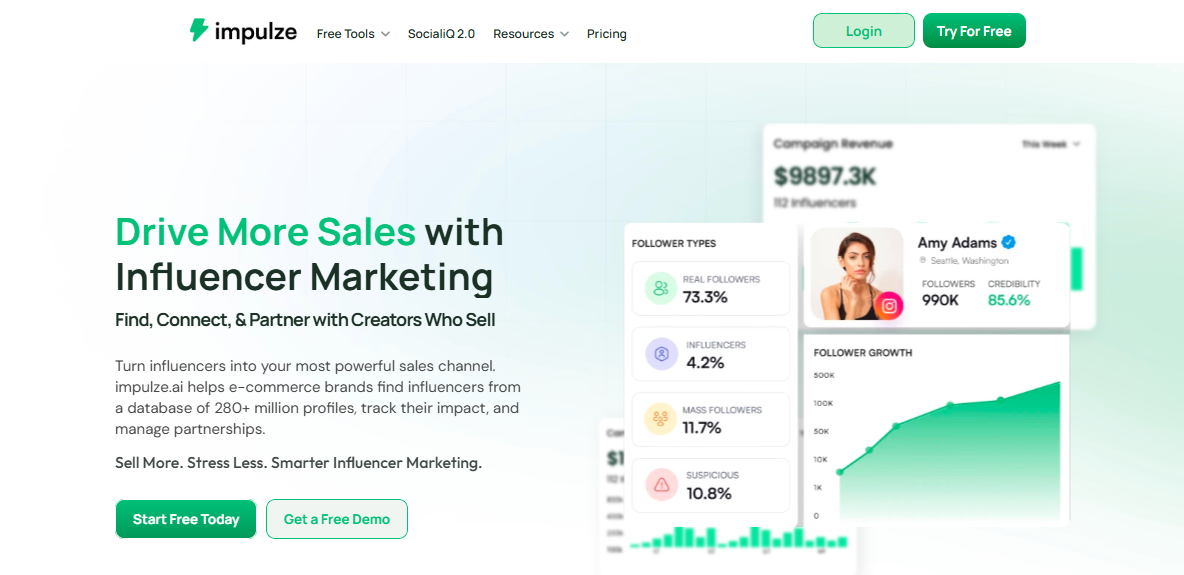
Best For: Impulze is best suited for small to mid-sized eCommerce brands, particularly those focusing on brand awareness campaigns and influencer partnerships across multiple markets.
Platform Coverage:
- TikTok
- YouTube
Pricing: All plans are flexible, with no strict contracts.
- Starter Plan: $89/month, includes core features and access to the influencer database.
- Quarterly Plan: Offers a 20% discount for extended use.
- Yearly Plan: Additional benefits, including deeper integrations, with the most cost-effective pricing.
Reviews: 4.5 / 5 (G2)
Ease of Use (UX/UI): Users highlight Impulze’s intuitive interface, with structured workflows that simplify influencer discovery and campaign management. However, some note occasional complexity in managing external tasks like gifting.
Customer Support: Impulze receives positive feedback for its responsive technical support team, which actively incorporates customer feedback into platform updates. Dedicated account managers are only available on higher-tier plans.
Impulze Standout Features:
- Influencer Discovery with 300M+ profiles: Advanced filters by country, niche, size, and competitor mentions.
- AI-Powered Outreach: Automated email outreach with customizable templates, no email integration required.
- Influencer Relationship Management (IRM): Custom lists, stages, and notes to streamline communication.
- Real-Time Engagement Tracking: Social IQ Chrome extension provides live engagement data.
- Similarity Search: Identify influencers similar to high-performing profiles or those engaging with competitors.
- Hashtag-Based Auto Content Tracking: Upcoming feature that auto-populates campaign content using hashtags.
- Bitly Integration for Link Tracking: Allows URL performance monitoring within campaigns.
Impulze Pros and Cons
Top 10 Impulze Alternatives
1. Influencer Hero
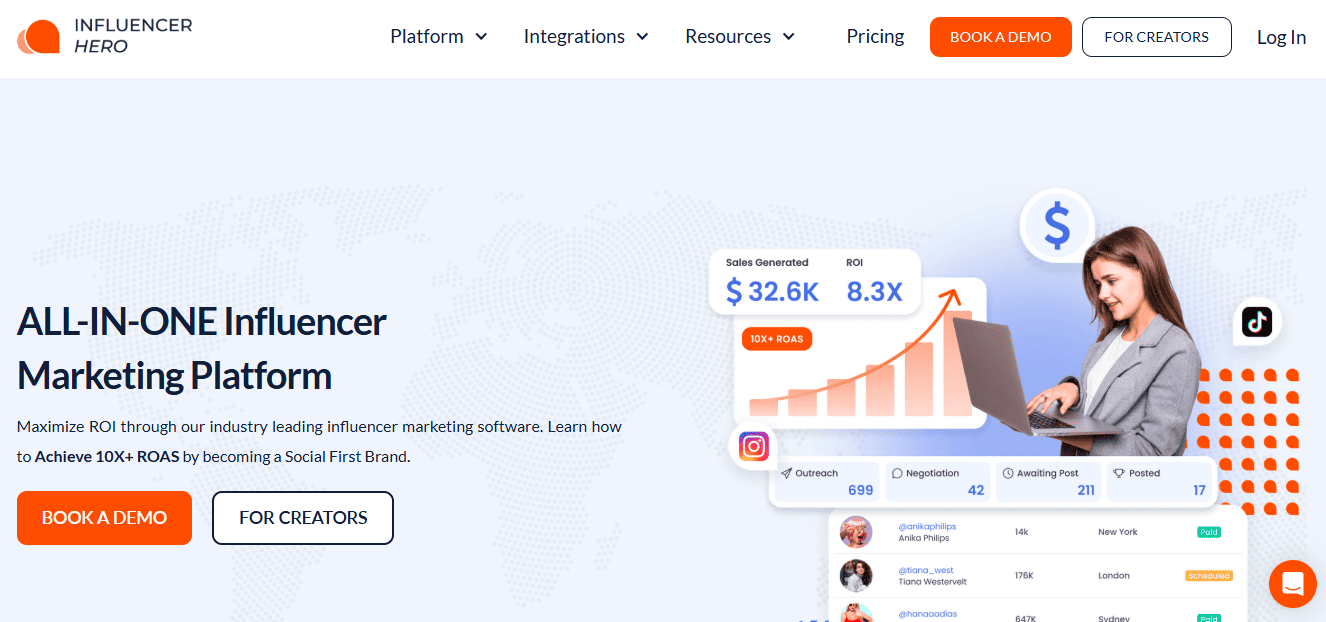
Best For: Influencer Hero is best for D2C brands and eCommerce teams that want to scale influencer marketing campaigns with automation, deep insights, and end-to-end management from discovery to affiliate payments.
Platform Coverage:
- TikTok
- YouTube
- Snapchat
- X (Twitter)
- Twitch
Pricing: Influencer Hero offers different plans for every brand’s needs:
- Standard Plan: $649/month (up to 1,000 creators)
- Pro Plan: $1,049/month (up to 5,000 creators)
- Business Plan: $2,490/month (up to 10,000 creators)
- Custom & Agency Plan: Tailored pricing based on brand needs
Reviews: 5.0 / 5.0 (Capterra)
Ease of Use (UX/UI): Influencer Hero is known for its clean, intuitive design with an easy-to-navigate dashboard and drag-and-drop workflows. Automated sequences and customizable email templates streamline campaign creation, while AI-powered suggestions make scaling campaigns seamless and efficient.
Customer Support: Customer support is one of Influencer Hero’s strongest features. The platform offers 24/7 real-human live chat, responsive email support, and an extensive Help Center with tutorials. Every plan includes a dedicated account manager from day one, while Pro users also benefit from a private Slack channel for faster and continuous support.
Influencer Hero’s Standout Features:
- Advanced Influencer Discovery: AI-assisted search with deep filters, fake follower detection, and brand-following detection.
- AI-Powered Outreach: Smart automated email sequences with personalized templates and drip campaigns.
- AI-Driven CRM & Analytics: Visual boards, automated follow-ups, and real-time performance dashboards.
- Chrome Extension: Instantly pull influencer stats while browsing social media and add them to campaigns.
- Multi-Platform eCommerce Support: Native integrations with Shopify, WooCommerce, and custom builds for seamless gifting and affiliate tracking.
- Influencer Brand Followers Detection: Identify and engage creators who already follow your brand for authentic collaborations.
- Customizable Influencer Storefronts: Enable influencers to showcase and sell products directly, increasing affiliate conversions.
Influencer Hero’s Pros and Cons
Impulze vs Influencer Hero
Impulze focuses on providing influencer analytics and campaign management but is limited by its narrower platform coverage and fewer automation features. Pricing for Impulze is less transparent and often tied to annual contracts, creating challenges for brands needing flexibility.
Influencer Hero, by contrast, offers transparent monthly pricing starting at $649 with unlimited campaigns and robust AI-powered features. Unlike Impulze, it provides full eCommerce integrations, advanced CRM, automated outreach, and influencer storefronts, making it a more complete solution.
For brands seeking a cost-effective, scalable, and all-in-one influencer marketing platform, Influencer Hero clearly outshines Impulze, offering superior automation, insights, and support to drive ROI.
2. Traackr

Best For: Traackr is best suited for enterprise brands, particularly in beauty, fashion, and lifestyle, that require advanced influencer performance benchmarking, ROI tracking, and budget optimization across multiple regions.
Platform Coverage:
- TikTok
- YouTube
- X (Twitter)
Pricing: Pricing is fully customized, but users note limited transparency during scoping.
- Standard Plan: $32,500/year (annual contract)
- Custom Modules: Additional pricing depending on features and scale
Reviews: 4.3 / 5.0 (G2)
Ease of Use (UX/UI): Users describe Traackr’s interface as clean and logically structured, simplifying influencer management once users are trained. However, mastering its advanced analytics and benchmarking tools requires a steep learning curve, especially for smaller teams.
Customer Support: Traackr is known for exceptional customer success and onboarding, providing responsive support and strategic consulting. Users highlight that the support team is proactive in helping brands optimize campaigns, though some mention minor delays during busy periods.
Traackr Standout Features:
- Advanced Influencer Discovery: Access to 6M+ influencers with granular filters based on engagement, demographics, and past brand collaborations.
- Comprehensive CRM & Relationship Tracking: Centralized influencer management with custom tags, shared notes, and email workflow integration.
- Real-Time Analytics & ROI Reporting: Granular reports including CPC, CPE, CPV, engagement rates, and ROI with live benchmarking.
- Brand Vitality Score (BVS): Proprietary metric combining visibility, trust, and influence to measure brand equity compared to competitors.
- Budget Optimization Calculator: Predicts optimal creator spend based on historical performance, platform benchmarks, and content type.
- Cost-Per Metrics Dashboard: Tracks CPC, CPE, CPV, and cost-per-story-view to analyze spend efficiency.
- Live Campaign Benchmarking: Allows performance comparison against industry standards in real-time for mid-campaign optimization.
Traackr Pros and Cons
Impulze vs Traackr
Impulze offers an affordable entry point at $89/month, making it attractive for small to mid-sized brands looking for influencer discovery and campaign management without committing to a large budget. It provides real-time engagement tracking and a straightforward interface but lacks advanced analytics and in-platform payment processing.
Traackr, on the other hand, caters to enterprise teams with a focus on deep analytics, global benchmarking, and budget optimization. Its proprietary tools like the Brand Vitality Score and Budget Optimization Calculator make it ideal for performance-driven marketers with larger budgets. However, its high annual cost (~$32K/year) and steep learning curve limit its accessibility for smaller businesses.
For brands prioritizing cost efficiency and simplicity, Impulze is the better choice. For companies needing enterprise-grade analytics, global discovery, and advanced ROI tracking, Traackr justifies its premium pricing.
3. Upfluence

Best For: Upfluence is best suited for eCommerce brands on Shopify or Amazon that want to scale influencer campaigns while directly tracking ROI from collaborations and sales attribution.
Platform Coverage:
- TikTok
- YouTube
- X (Twitter)
- Twitch
- WordPress Blogs
Pricing: No commissions on influencer sales or outreach volume.
- Annual Contract (Monthly Billing): $1,276/month ($16,007/year)
- Annual Contract (Paid Upfront): $14,406/year
- Option to remove payment features (-$399/month) if only using gifting.
Reviews: 4.3 / 5.0 (G2)
Ease of Use (UX/UI): Users find Upfluence’s interface intuitive, with easy navigation between influencer search, outreach, and campaign tracking. However, new users mention a steep learning curve during the initial setup due to its robust features.
Customer Support: Customer support is reported as responsive and helpful, with strong onboarding assistance. Users appreciate the guidance provided during campaign optimizations, though the rigid annual contract structure limits flexibility.
Upfluence Standout Features:
- AI-Powered Influencer Discovery: Access to 12M+ influencers with advanced filters and AI campaign assistant (Jace AI) for automated outreach.
- Integrated CRM & Campaign Management: Centralized management of influencer relationships and campaign workflows.
- Advanced Reporting & Analytics: Track sales, engagement, clicks, reach, impressions, and individual influencer ROI.
- Shopify & Amazon Integrations: Directly identify customer-influencers, track affiliate performance, and manage product gifting seamlessly.
- Bulk Payments: Securely process multiple influencer payouts directly in the platform.
- Social Listening: Analyze market trends, monitor competitor campaigns, and access top-performing content.
- Custom Importing: Upload and manage influencers you have previously worked with to maintain relationships and streamline outreach.
Upfluence Pros and Cons
Impulze vs Upfluence
Impulze is designed for brands looking for an affordable solution to manage influencer discovery and campaigns, with pricing starting at $89/month. It offers a massive influencer database, real-time engagement tracking via its Social IQ Chrome extension, and an intuitive UI ideal for small to mid-sized brands. However, its analytics are more basic, and product gifting requires external management.
Upfluence, on the other hand, is a premium tool built for eCommerce-focused brands, particularly those using Shopify or Amazon. It excels at tracking sales directly tied to influencer marketing, automating outreach with Jace AI, and managing affiliate programs seamlessly. Its pricing starts at $16K/year, making it more suited for brands with larger budgets.
For brands prioritizing cost-effectiveness and simplicity, Impulze is a strong choice. However, for businesses aiming to tie influencer campaigns directly to revenue and leverage deep eCommerce integrations, Upfluence justifies its higher price point.
4. Captiv8

Best For: Captiv8 is best for enterprise brands and agencies looking to manage large-scale influencer marketing campaigns with advanced AI analytics and in-depth audience insights.
Platform Coverage:
- TikTok
- YouTube
- X (formerly Twitter)
- Twitch
Pricing:
- Starter Plan: Around $2,000/month (annual contract)
- Professional Plan: Custom pricing, typically starting from $5,000/month (annual contract)
- Enterprise Plan: Fully customized pricing based on campaign scale and features needed
Reviews: 4.5 / 5 (G2)
Ease of Use (UX/UI): Users report that Captiv8 has an intuitive interface with clear dashboards that make campaign management straightforward. However, due to its enterprise-level features, there is a slight learning curve when onboarding new team members.
Customer Support: Captiv8’s support team is praised for being responsive and knowledgeable, offering personalized onboarding and training sessions. Some users mention that response times can vary during peak campaign periods.
Captiv8 Standout Features:
- Advanced Influencer Discovery: AI-powered search with over 1M+ creators and detailed audience insights.
- AI-Powered Outreach: Automated influencer recommendations and outreach workflows.
- Robust CRM: Centralized creator relationship management with tracking of campaign history and communications.
- Real-Time Analytics: Comprehensive reporting including engagement metrics, audience demographics, and ROI tracking.
- Content & UGC Management: Streamlined process for managing and approving creator-generated content.
- Audience Affinity Data: Provides deep analytics on audience interests and brand affinities for better targeting.
- Fraud Detection & Brand Safety: Built-in tools to detect fake followers and ensure brand-safe partnerships.
Captiv8 Pros and Cons
Impulze vs Captiv8
Impulze offers a more budget-friendly solution geared toward small to mid-sized brands, while Captiv8 caters to enterprise-level organizations that require sophisticated analytics and a broader creator database. Captiv8’s pricing starts significantly higher, reflecting its AI-powered features, brand safety tools, and deep audience data.
For businesses with smaller budgets or those just starting influencer marketing, Impulze is a cost-effective choice with strong core features. On the other hand, Captiv8 is ideal for brands that need scalability, advanced reporting, and AI-driven insights to manage complex campaigns at scale. If ROI tracking, fraud detection, and high-touch support are priorities, Captiv8 stands out despite the higher investment.
5. CreatorIQ

Best For: CreatorIQ is best for large-scale enterprises and global brands that need an end-to-end influencer marketing platform with advanced analytics, robust integrations, and strategic support.
Platform Coverage:
- TikTok
- YouTube
- Twitch
- X (Twitter)
Pricing: CreatorIQ operates on annual contracts only. Pricing ranges between $2,000–$5,000 per month depending on the selected plan, with an additional 2% creator payout fee after $100K/year and optional add-ons like Creator Connect for $15,000/year.
Reviews: 4.6 / 5 (Capterra)
Ease of Use (UX/UI): Users appreciate CreatorIQ’s modern and data-rich interface, but note that the vast amount of features requires a learning curve. The customizable dashboards, AI-driven search, and seamless integrations are praised for improving workflow efficiency.
Customer Support: The platform is known for excellent customer support, offering a dedicated implementation manager, customer success team, and quarterly strategic input. Many users highlight that CreatorIQ offers “not just software, but strategic expertise” to guide campaigns.
CreatorIQ Standout Features:
- Advanced Influencer Discovery: AI-powered search with semantic keyword matching and over 20M+ creator profiles enriched with audience and performance data.
- AI-Powered Outreach: Automated workflows and smart recommendations to streamline influencer recruitment and communication.
- Robust CRM: Centralized platform to manage influencer relationships, track interactions, and monitor campaign progress.
- Real-Time Analytics: Live dashboards with customizable KPIs, engagement metrics, and ROI reporting for accurate campaign evaluation.
- Content & UGC Management: Automated content collection, approval workflows, and usage rights tracking for seamless UGC repurposing.
- Branded Creator Connect Pages: Unique portals allowing creators to apply directly to brand campaigns, feeding data into the CRM.
- Affiliate & Payment Integration: Built-in influencer payment management with tax compliance and affiliate tracking tools.
CreatorIQ Pros and Cons
Impulze vs CreatorIQ
Impulze offers a cost-effective solution at $89/month, making it attractive for small to mid-sized brands, while CreatorIQ’s enterprise pricing ($2K–$5K/month) is suited to organizations with larger budgets. CreatorIQ provides end-to-end campaign lifecycle management with deeper API integrations, advanced analytics, and built-in payment processing, features that Impulze currently lacks or offers externally.
While Impulze is easier to adopt for beginners with its intuitive UI and affordable plans, CreatorIQ stands out for global scalability, strategic support, and real-time API data. Brands with complex influencer operations, multiple stakeholders, and a need for comprehensive compliance will find CreatorIQ more aligned with their needs. However, for those prioritizing affordability and simplicity, Impulze remains a strong contender.
6. HypeAuditor

Best For: HypeAuditor is best suited for brands seeking deep influencer analytics and audience authenticity checks, particularly in markets where fake followers and fraudulent engagements are a concern. Its tools also benefit agencies managing multi-channel campaigns with strong ROI tracking.
Platform Coverage:
- TikTok
- YouTube
- Twitch
- X (Twitter)
- Snapchat
Pricing: HypeAuditor offers a customizable pricing structure starting at around $10,000/year for its Business plan, which includes 2,000 reports. Additional modules and reports can be purchased, making it scalable for enterprise needs. A 24–48 hour free trial is available.
Reviews: 4.5 / 5 (G2)
Ease of Use (UX/UI): Users highlight that the interface is comprehensive and analytics-rich, but it can be overwhelming at first. Advanced filtering and reporting options require a learning curve but deliver powerful insights once mastered.
Customer Support: HypeAuditor provides responsive email support and onboarding sessions. While many users are satisfied with the training, some note the need for ongoing guidance to fully leverage advanced features.
HypeAuditor Standout Features:
- Advanced Influencer Discovery: AI-powered search across 50M+ profiles with granular filters and authenticity scoring.
- AI-Powered Outreach: Personalized outreach campaigns with built-in templates and automated follow-ups.
- Robust CRM: Organize influencer lists, track campaign progress, and maintain communication history in one platform.
- Real-Time Analytics: In-depth reporting covering audience demographics, engagement quality, ROI, and campaign performance.
- Content & UGC Management: Centralized content hub with approval workflows and asset libraries for campaign assets.
- Audience Affinity Data: Detailed insights into audience interests, brand affinities, and influencer-brand fit scores.
- Fraud Detection & Brand Safety: Proprietary algorithms to detect fake followers, suspicious activity, and ensure brand-safe collaborations.
HypeAuditor Pros and Cons
Impulze vs HypeAuditor
Impulze positions itself as a cost-effective solution with plans starting at $89/month, making it accessible to small and mid-sized brands. In contrast, HypeAuditor caters to enterprise-level clients with a higher entry cost of $10,000/year, offering more advanced analytics and fraud detection capabilities.
While both platforms offer influencer discovery and campaign management, HypeAuditor stands out with its audience authenticity tools and AI-driven insights, making it ideal for brands needing in-depth data validation. Impulze, however, provides real-time engagement tracking via its Social IQ extension and a more intuitive interface, which is easier for new users. For brands prioritizing affordability and ease of use, Impulze is a strong choice, whereas HypeAuditor is better suited for enterprises requiring advanced analytics and fraud prevention.
7. GRIN

Best For: GRIN is best for DTC and eCommerce brands that need an end-to-end influencer marketing platform with deep integrations for product seeding, affiliate tracking, and UGC management.
Platform Coverage:
- TikTok
- YouTube
- X (Twitter)
- Twitch
- Snapchat
Pricing: GRIN offers custom plans starting around $2,500/month, scaling up to $10,000+/month depending on features and campaign volume.
It requires a minimum 12-month commitment.
Reviews: 4.5 / 5.0 (G2)
Ease of Use (UX/UI): Users appreciate GRIN’s all-in-one workflow, intuitive dashboards, and seamless integration with eCommerce platforms. However, some mention occasional glitches, slow loading, and performance issues when managing large campaigns.
Customer Support: Customer support is generally praised for its onboarding assistance and optional strategic guidance. That said, several users report inconsistent response times and occasional unresolved tickets.
GRIN Standout Features:
- AI-Powered Discovery: Keyword-based and lookalike influencer search with intelligent suggestions via GRIN’s agentic AI (Gia).
- Integrated CRM: Centralized creator relationship management with task automation and personalized influencer portals.
- Real-Time Reporting: ROI-focused analytics with affiliate revenue tracking and campaign performance insights.
- Advanced UGC Library: Automatically stores and organizes all creator content, including Instagram Stories, for easy repurposing.
- E-Commerce Native Workflows: Deep Shopify, WooCommerce, and Magento integrations to handle gifting, discount codes, and tracked sales seamlessly.
- Affiliate Hub & In-App Payments: Built-in PayPal payments and affiliate tracking tools for simplified commission management.
- Landing Pages for Creator Recruitment: Branded pages to attract inbound influencer applications and warm leads.
GRIN Pros and Cons
Impulze vs GRIN
Impulze is known for its affordability, with pricing starting at just $89/month, making it highly attractive for small to mid-sized brands. It offers real-time engagement tracking via its Social IQ extension but lacks built-in payment processing and advanced gifting automation.
On the other hand, GRIN is a premium platform tailored for established eCommerce brands. It combines advanced features like in-app PayPal payments, UGC rights management, and affiliate commission tracking—all within a single ecosystem. While its pricing is steep and requires annual commitments, brands that need robust eCommerce workflows and unlimited creator partnerships may find GRIN worth the investment.
For businesses prioritizing cost-effectiveness and ease of use, Impulze offers strong value, but for brands seeking an all-in-one enterprise-grade solution, GRIN remains a top choice.
8. AInfluencer
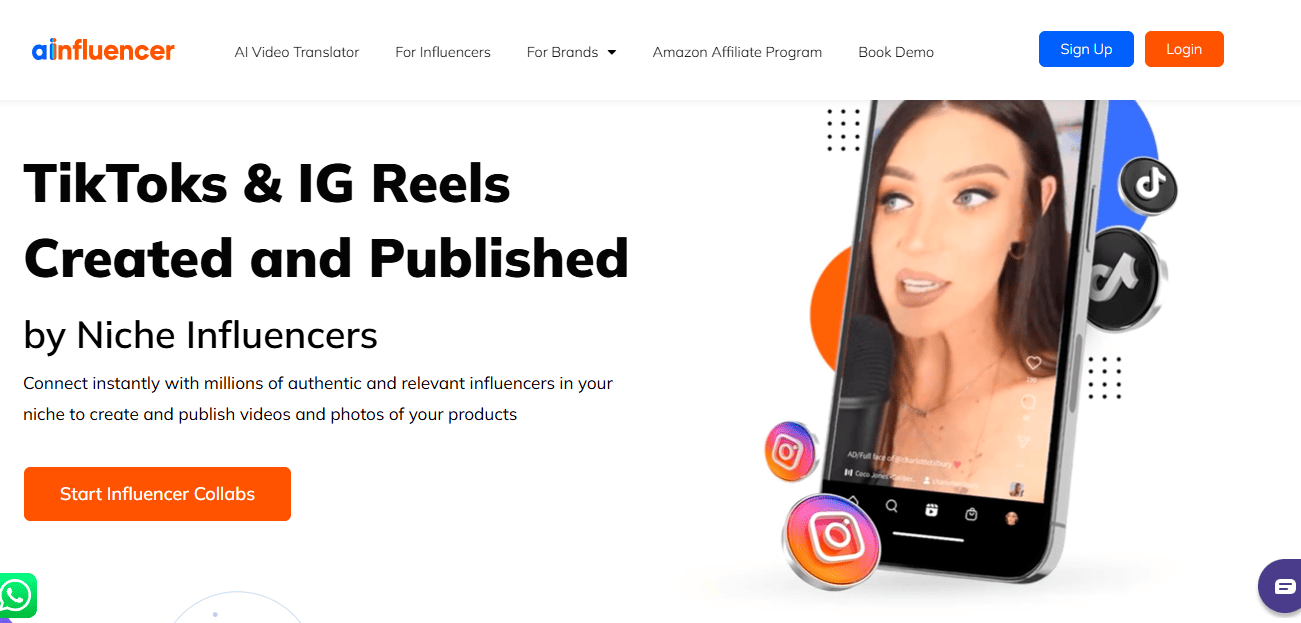
Best For: AInfluencer is best for small to mid-sized brands seeking a free, self-service platform to connect with influencers through an in-app marketplace. It is particularly suitable for campaigns on Instagram and TikTok where quick negotiation and escrow-protected payments are critical.
Platform Coverage:
- TikTok
Pricing:
- Free Plan: Self-service with no software fees or usage limits (brands only pay influencers directly).
- Turbo Viral: $29,999 for 4 months (200 influencers, 100M+ followers).
- Super Scale: $15,000 for 3 months (75 influencers, 55M+ followers).
- Scale: $9,999 for 2 months (50 influencers, 7.5M+ followers).
- Viral: $7,999 for 1 month (25 influencers, 2.5M+ followers).
Reviews: 4.3 / 5 (Capterra)
Ease of Use (UX/UI): Users appreciate the platform’s simplicity, allowing brands to create campaigns and manage negotiations quickly. However, its analytics dashboard is seen as basic, and uploading creator performance screenshots can feel outdated for data-driven teams.
Customer Support Support: is primarily email-based with responses considered helpful but sometimes slow during peak campaign seasons. Managed service clients report more attentive support and smoother campaign execution.
AInfluencer Standout Features:
- Influencer Discovery: Marketplace of 5M+ creators with filters by location, niche, fees, and language.
- AI-Powered Outreach: Automated campaign invite generation and message personalization via AI.
- Escrow-Based Payments: Secure payment system that protects brands by only releasing funds upon content delivery.
- Content Library & Ownership: Brands can download and own all delivered content, with approval/rejection options.
- In-App Creator Engagement: Direct communication and proposal handling through AInfluencer’s mobile app.
- Chrome Extension: Streamlined outreach by sending campaign invites directly from Instagram profiles.
- Upcoming Shopify Integration: Will allow automated gifting fulfillment and product insurance for high-value items.
AInfluencer Pros and Cons
Impulze vs AInfluencer
Impulze offers a more structured influencer discovery engine with AI-powered search filters, competitor insights, and campaign tracking tools, while AInfluencer relies on a marketplace approach where influencers apply to brand campaigns. Pricing-wise, Impulze starts at $89 per month, making it budget-friendly for brands, whereas AInfluencer’s managed campaigns come at a steep cost, with plans reaching $30,000.
In terms of features, Impulze excels in analytics, real-time engagement tracking, and CRM functionalities, which AInfluencer lacks. However, AInfluencer provides unique benefits like escrow payments and full content ownership, making it ideal for brands prioritizing secure transactions and content control.
Brands seeking advanced analytics, automated workflows, and a scalable system may lean toward Impulze, while those needing a free entry-level solution with protected payments could consider AInfluencer.
9. Influencity
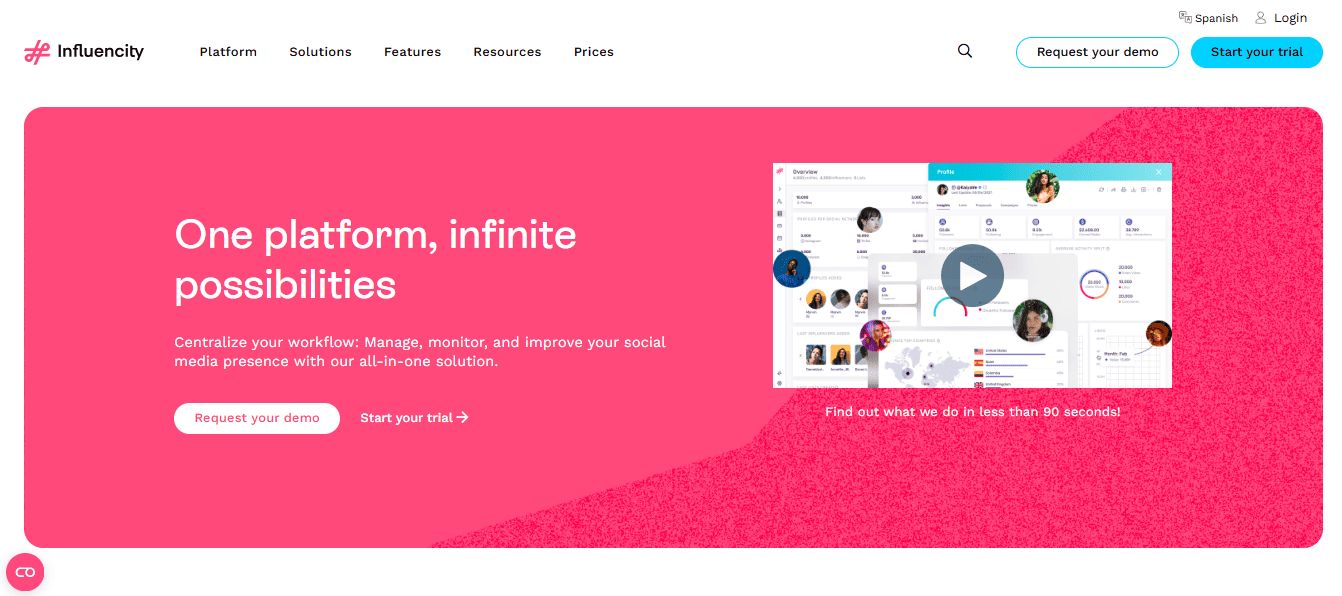
Best For: Influencity is best for brands seeking a scalable, all-in-one influencer marketing solution that leverages public data for influencer discovery and integrates seamlessly with Shopify for affiliate and gifting campaigns.
Platform Coverage:
- TikTok
- YouTube
- Twitter (analytics only)
Pricing:
- Professional Plan: $3,816 per year (includes 10,000 monthly searches, 150 profile unlocks, 1,200 outreach emails/month, 10 campaign boards, Shopify integration, and access for 5 users)
- Business Plan: Custom pricing with extended features
- Tracker Add-On: $660/year for tracking 50 influencers (customized pricing for other volumes)
Reviews: 4.6 / 5.0 (Capterra)
Ease of Use (UX/UI): Users appreciate Influencity’s intuitive interface, particularly the Trello-like campaign board for tracking tasks, deadlines, and approvals. The visual CRM and automated outreach workflows simplify campaign management, though the initial onboarding process can feel lengthy.
Customer Support: Support is generally responsive, providing thorough guidance during setup and campaign execution. However, some users mention the 4–6 week onboarding period can delay full adoption, though assistance remains available throughout.
Influencity Standout Features:
- Smart Influencer Discovery: AI-powered keyword and hashtag matching with audience lookalike suggestions.
- Automated Outreach: Email sequences with open, click, and reply tracking.
- Visual CRM: Organized influencer lists with segmentation by campaign type, country, or theme.
- Advanced Reporting: Automated and manual tracking with detailed analytics on KPIs, cost breakdowns, and performance forecasting.
- Shopify Integration: Direct management of gifting and affiliate workflows, including discount code tracking.
- Branded Application Pages: Custom pages to collect inbound influencer applications.
- Public Data Network: Access to 15M+ influencers without requiring opt-in, expanding discovery potential.
Influencity Pros and Cons
Impulze vs Influencity
Impulze provides an affordable entry point at $89/month, making it attractive for small to mid-sized brands. It excels in real-time engagement tracking via its Social IQ Chrome extension and offers intuitive influencer search filters. However, its gifting and payment workflows require external tools, and some features like automated content tracking are still in beta.
Influencity, while more expensive with its $3,816/year plan, offers a more comprehensive suite. Its Shopify integration for gifting and affiliate tracking, automated campaign reporting, and public data-based discovery set it apart for brands managing high-volume influencer collaborations.
For brands with limited budgets, Impulze is a solid choice, but those needing advanced integrations, automated reporting, and scalable workflows may find Influencity’s higher cost justified.
10. Favikon
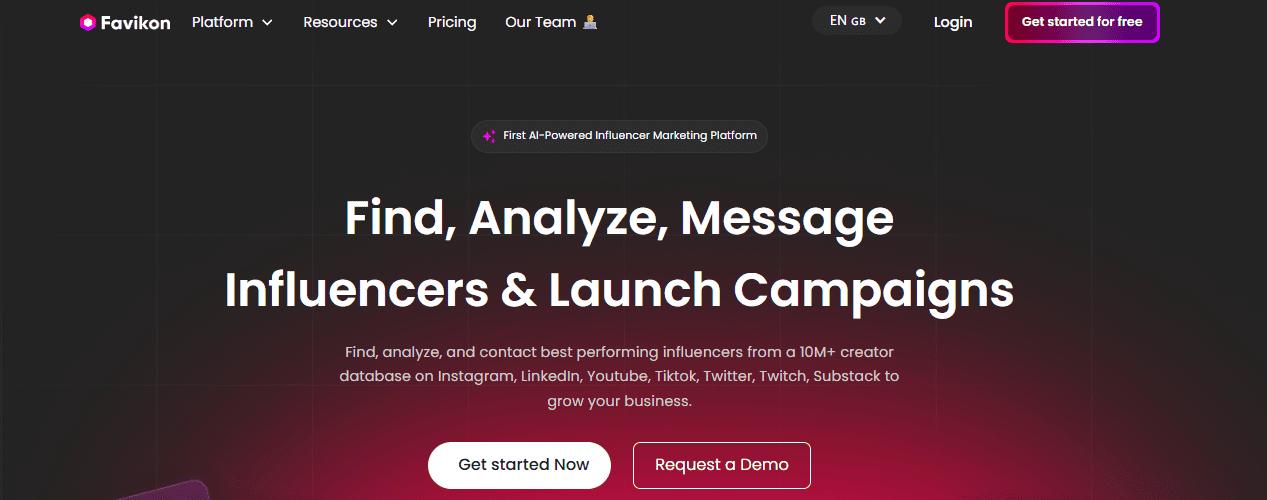
Best For: Favikon is best for data-driven brands and agencies seeking a precise, AI-powered solution to evaluate influencer authenticity and manage collaborations across multiple platforms.
PlatformCoverage:
- TikTok
- YouTube
Pricing: There are different plans and options:
- Starter: $69/year – up to 5,000 creators, 20 audience analyses, CRM (100 contacts).
- Standard: $139/year – up to 50,000 creators, 100 audience analyses, CRM (1,000 contacts), bulk outreach.
- Pro: $299/year – unlimited discovery, 500 audience analyses, CRM (5,000 contacts), advanced tracking, premium support.
Reviews: 4.5 / 5 (G2)
Ease of Use (UX/UI): Users appreciate the clean dashboard and powerful analytics but mention that the abundance of data can be overwhelming initially. The Chrome extension makes prospecting seamless, reducing the learning curve over time.
Customer Support: Favikon offers 24/7 chatbot support and personalized onboarding for higher plans. Users report fast responses but limited live human interaction on entry-level plans.
Favikon Standout Features:
- Advanced Influencer Discovery: AI-powered search with proprietary scoring to rank creators based on audience quality and authenticity.
- AI-Powered Outreach: Direct messaging tools with segmentation options for targeted campaigns.
- Integrated CRM: Manage influencer relationships with tagging, notes, and campaign history tracking.
- Advanced Analytics Dashboard: Real-time campaign reporting with audience insights and ROI tracking.
- Chrome Extension Prospecting: Evaluate and import influencers directly from social media with one click.
- Multi-Network Insights: Includes LinkedIn discovery, rare among influencer platforms, ideal for B2B targeting.
- White Labeling & Customization: Branding options for agencies and advanced teams to present data to clients seamlessly.
Favikon Pros and Cons
Impulze vs Favikon
When comparing Impulze with Favikon, the primary difference lies in their approach. Impulze focuses on streamlined campaign management with real-time engagement tracking and affordable pricing at $89/month, making it attractive for brands starting or scaling on a budget. Favikon, on the other hand, emphasizes data depth, AI-driven influencer scoring, and multi-network insights, catering to brands that prioritize audience quality verification.
While Impulze offers easier onboarding and a user-friendly UI, Favikon provides more advanced analytics and LinkedIn discovery, which Impulze lacks. Pricing is also structured differently—Impulze offers monthly flexibility, whereas Favikon uses low-cost annual plans.
Brands looking for simplicity and real-time tracking may lean toward Impulze, while those valuing AI-driven authenticity checks and multi-network strategies may prefer Favikon.
Final Thoughts
While Impulze is an affordable and easy-to-use platform, it lacks advanced analytics, built-in payment solutions, and broad integrations. Alternatives like Traackr, CreatorIQ, and Upfluence serve enterprise brands with robust analytics and global scalability, while Favikon and Influencity stand out for data depth and niche targeting.
Influencer Hero is one of the best alternatives, offering an all-in-one platform with AI-powered discovery, advanced CRM, analytics, gifting, affiliate tracking, and customizable storefronts—all with flexible pricing and premium 24/7 support. Want to scale your influencer marketing? Book a demo with Influencer Hero and see how it can transform your campaigns!

While Impulze offers strong influencer discovery and affordable pricing, users often look for alternatives due to its limited analytics, lack of built-in payment solutions, and restricted integrations with eCommerce platforms. Tools like Influencer Hero provide a more complete solution with advanced CRM, automated outreach, UGC management, and affiliate tracking.
For eCommerce brands on Shopify or Amazon, Influencer Hero is a top choice because it combines influencer discovery, gifting, affiliate payments, and storefront creation in one platform. Other strong options include Upfluence for its Shopify integration and GRIN for its deep eCommerce workflows.
If your priority is advanced analytics and ROI tracking, platforms like Traackr and CreatorIQ excel with real-time benchmarking and custom reporting dashboards. Influencer Hero also offers AI-driven analytics and real-time campaign performance tracking, making it ideal for data-driven brands.
Yes, Influencer Hero stands out for its transparent monthly pricing starting at $649, with no hidden fees or rigid annual contracts. In contrast, many enterprise tools like CreatorIQ and GRIN require costly annual commitments.
Influencer Hero is one of the few platforms that seamlessly combines influencer marketing, affiliate payments, and customizable storefronts to boost sales. Upfluence and GRIN also support affiliate tracking but lack the storefront functionality offered by Influencer Hero.
Blogs más populares
¿Estás listo para lograr un ROI de más de 10 veces?
Programa una demostración con uno de nuestros expertos en medios a continuación.

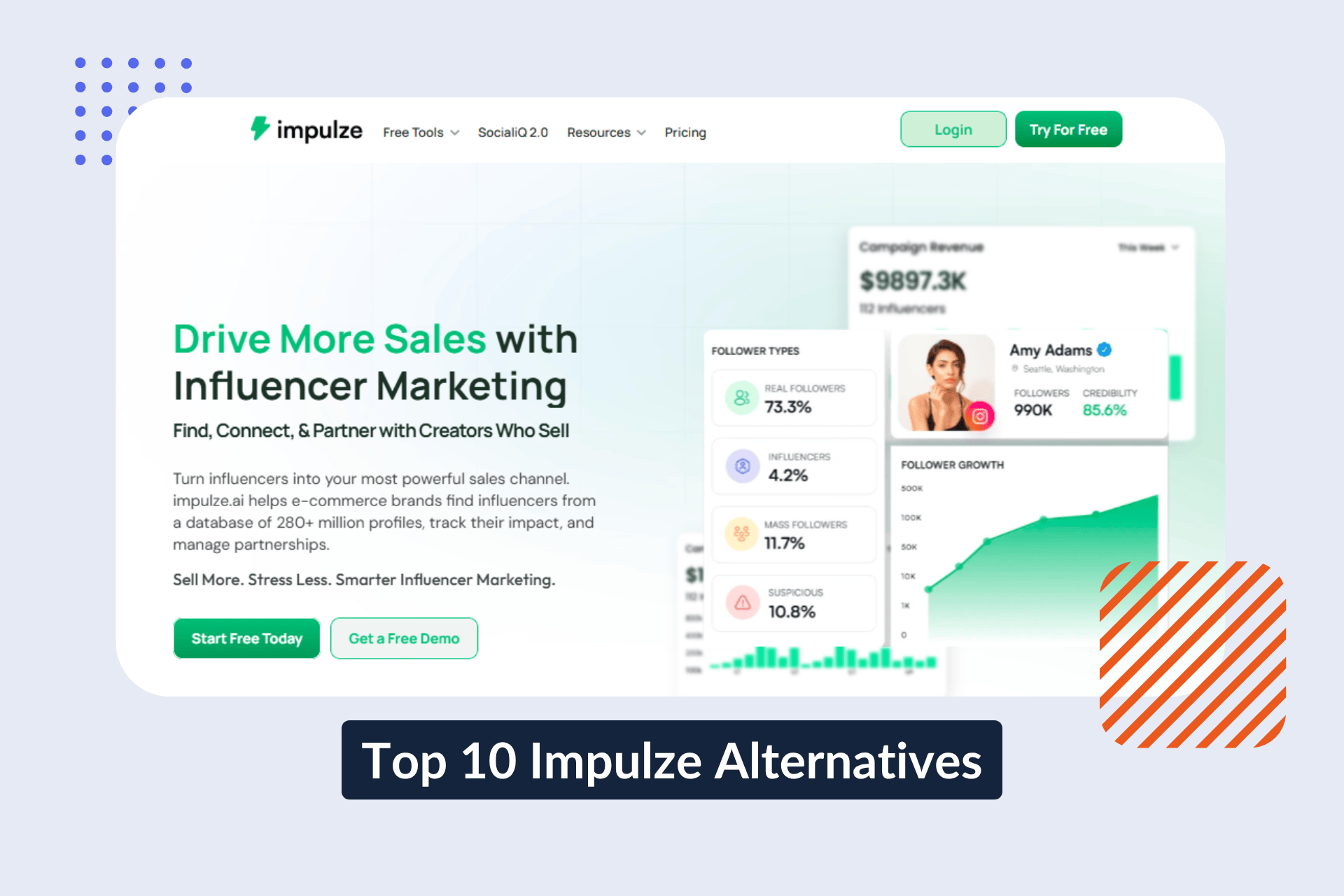



.jpg)











.png)




